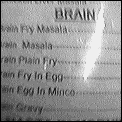2 history lessons today: Dervala writes about the Brehon Laws of ancient Ireland. Dervala's weblog has become a great source of smart reading material, and is firmly on my daily list.
History: The Electronic Telegraph: Code-breaker reveals a diarist to rival Pepys (via forteana). Not quite as saucy as old Sam, though; he was a Puritan. Shame.
 Food: The World's
Worst Food, courtesy of Joe McNally via NTK. A bit short of the
traditional brain/tongue/tripe
dishes however. (Relevant: low grade meat products, urgh.)
Food: The World's
Worst Food, courtesy of Joe McNally via NTK. A bit short of the
traditional brain/tongue/tripe
dishes however. (Relevant: low grade meat products, urgh.)
SCOvEveryone: Economist interview with Darl McBride of SCO. Interestingly, it notes 'in 1998, Mr McBride himself won what he calls a 'seven-figure settlement' by suing his employer at the time, IKON Office Solutions (who, he says, had breached contract by urging him to move to an office outside Utah).' Nice! However, the SCO management page doesn't mention that, for some reason... (Link)
Date: Fri, 29 Aug 2003 09:45:13 +0100
From: "Martin Adamson" (spam-protected)
To: (spam-protected)
Subject: Code-breaker reveals a diarist to rival Pepys
The Electronic Telegraph: Code-breaker reveals a diarist to rival Pepys
(Filed: 29/08/2003)
A Puritan's journal written in cryptic shorthand to foil the King's men paints a vivid picture of 1600s London, reports Will Bennett
A remarkable million-word account of life in late 17th century England which is as vivid as Samuel Pepys's diary has been transcribed by experts after lying largely forgotten for more than three centuries.
A specialist code-breaker was brought in to crack the shorthand that Roger Morrice, a Puritan minister turned political journalist, used in part of the diary to stop the King's agents reading it.
While Pepys's often hedonistic diary was long regarded as the most detailed record of life in Restoration England, Morrice's more strait-laced Entring Book gathered dust in a little-known British library.
The Entring Book was acquired by Dr Williams's Library in London, which specialises in the history of English Nonconformist churches, in the early 18th century and it remained there until a few years ago.
Then a team of academics based at Cambridge University launched a project to transcribe the diary, which covers the years 1677 to 1691 and presents an entirely different view of late 17th century England from that of Pepys.
Now the transcription has been completed and six volumes of Morrice's well-informed account of a turbulent period during which England was ruled by three different monarchs will be published in 2005.
About 40,000 words of the diary were in code and the team, led by the Cambridge academic Dr Mark Goldie, brought in an expert in 17th century shorthand to reveal for the first time what Morrice had written.
"At that time you could be arrested for sending newsletters and information around the country and so he did not want Charles II's and James II's agents to see what he had written," said Dr Goldie.
The shorthand expert, Dr Frances Henderson, from Oxford, not only cracked the code but discovered the names of some of Morrice's contacts, whose names he had written in cipher to protect their identities.
Then, as now, journalists had government sources, and Dr Henderson found that Morrice got much of his information from a man called Collins, an official at the Privy Council who was prepared to leak information to him.
As a convinced Puritan, Morrice was extremely critical of what he saw as the moral laxity of Restoration England. He described Tunbridge Wells, then a fashionable spa patronised by royalty, as "the most debauched town in the kingdom".
With evident approval, he reported the reaction of Ben Haddi Mor, the Moroccan ambassador to London, when some Englishmen urged the diplomat to "receive a whore into his bed".
"He said to our great rebuke and shame, 'My religion forbids whores, does not yours?'," wrote Morrice. "He said 'that when I come home I shall then be counted a liar in my own country for my master will not believe me that so many ladies came open-faced with bare breasts to see me'."
In the winter of 1683-84 the Thames froze so hard that coaches travelled across the ice, an ox was roasted and bullbaiting and other sports were held on the river's surface.
"The concourse and all manner of debauchery upon the Thames continued upon Lord's day and Monday the 3rd and 4th of this instant," wrote Morrice disapprovingly.
Morrice used one of his sources to get information about the birth of James Stuart, the Catholic heir to James II and later the Old Pretender.
"The child was a large full child in the head and the upper parts but not suitably proportioned in the lower parts," wrote Morris scathingly, appalled by the prospect of another Catholic monarch.
However, just a few months later Prince William of Orange's troops marched into London and installed the Protestant Dutchman as William III.
Morrice wrote that women "shook his soldiers by the hand as they came by and cried, 'Welcome, welcome, God bless you, you came to redeem our religion, laws, liberties and lives' ".